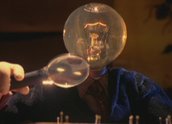
The Luminary (2005)
Synopsis
A grieving insect collector’s discovery of a missing specimen in his collection sparks a search for something more than just a moth.
Curator’s notes
The Luminary suggests two stories at once. The tale of the solitary moth collector’s search seems to tell another tale of 'amour fou’, mad or impossible love, and to comment on the sometimes cyclical nature of human folly. It does so with melancholic humour.
The film has no dialogue, instead using gesture, music and design to communicate its story. The insect collector’s light-bulb head opens up a world of metaphors that director Nicholas Kallincos uses to tell his story. Kallincos has fun with some overt symbolism, also making playfully explicit use of text with the self-help books in the entomologist’s library.
The film is nicely paced by Kallincos and editor Ben Joss to avoid heavy-handedness: the ending in particular is pleasingly abrupt. A beautiful aspect of this stop-motion animation is the world in miniature it creates, including the fussy details of the entomologist’s home and the texture of the woods outside. Atmospheric use of lighting and cinematography also help bring this world to life.
In 2008, The Luminary was re-edited to become a music video for the song 'Wishing on the Same Moon’ by Australian band Powderfinger. Kallincos is also a painter and trained as a scientist before turning to animation, and both influences show through in the film’s strong use of visual language and its themes and characters from science. Producer Shannon Owen is also a documentary director and producer. Her other works include Just Punishment (2006).
The Luminary screened at a number of international festivals, including the Melbourne, Brisbane, Seattle, Chicago and Sao Paulo International Film Festivals.
- Overview
- Curator’s notes
- Video full title
- Principal credits
- Find a copy
- Make a comment
- Add your review



